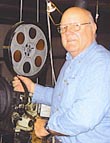|
|
This topic comprises 2 pages: 1 2
|
|
Author
|
Topic: The Crazy Things We Find in Film Cans
|
|
|
|
|
|
|
|
|
|
|
|
|
|
|
John Pytlak
Film God

Posts: 9987
From: Rochester, NY 14650-1922
Registered: Jan 2000
|
 posted 06-08-2004 05:57 AM
posted 06-08-2004 05:57 AM





Kodak has made print film on polyester (ESTAR) base since the 1950's. It was used primarily for small gauge films (16mm and Super-8 prints) and for special venue (e.g., 70mm IMAX films, theme parks).
Agfa-Gevaert was the first to really promote the use of polyester (GEVAR) base for 35mm theatrical prints. "The Fugitive", "Free Willy", "The Magic Garden", etc. were some of the first releases on Agfa polyester print film. Fuji followed suit with "The American President" in late 1995. A film on the earlier Kodak polyester print film (2386) was "Ace Ventura - When Nature Calls" in November 1995.
Kodak had concerns about the static performance and projector abrasion issues of polyester prints, as well as the need for proper tension-sensing failsafes. I worked on a report on a survey of polyester print use in theatres for the movie "Mr. Wonderful". My report to ShoWest in March 1994 reported the issues of shedding, static, and fear of equipment damage. Improvements were needed.
Kodak spent well over $200 Million addressing these issues, building a completely new ESTAR base manufacturing plant to add an abrasion-resistant, transparent, conductive anti-static backing to polyester film, found on the current Kodak VISION Color Print Films 2383 and 2393:
http://www.kodak.com/country/US/en/corp/pressReleases/pr19960509-01.shtml
That note is from the mid-1990s, BEFORE Kodak had introduced the significant improvements that VISION Color Print Films brought to the market.
| IP: Logged
|
|
|
|
|
|
|
|
|
|
|
|
|
|
|
|
|
|
All times are Central (GMT -6:00)
|
This topic comprises 2 pages: 1 2
|
Powered by Infopop Corporation
UBB.classicTM
6.3.1.2
The Film-Tech Forums are designed for various members related to the cinema industry to express their opinions, viewpoints and testimonials on various products, services and events based upon speculation, personal knowledge and factual information through use, therefore all views represented here allow no liability upon the publishers of this web site and the owners of said views assume no liability for any ill will resulting from these postings. The posts made here are for educational as well as entertainment purposes and as such anyone viewing this portion of the website must accept these views as statements of the author of that opinion
and agrees to release the authors from any and all liability.
|

 Home
Home
 Products
Products
 Store
Store
 Forum
Forum
 Warehouse
Warehouse
 Contact Us
Contact Us




 Printer-friendly view of this topic
Printer-friendly view of this topic









![[Big Grin]](biggrin.gif)
![[Eek!]](eek.gif)










